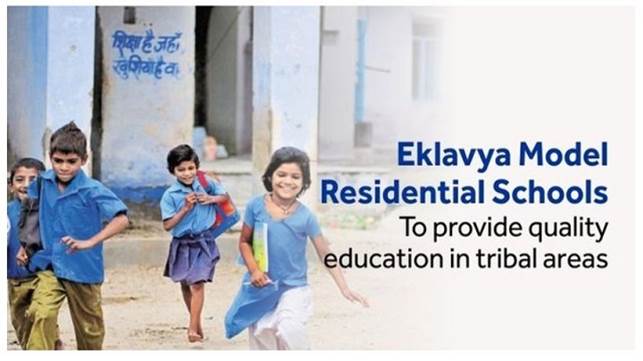Description

Copyright infringement not intended
In News
- Eklavya schools established by the Union Ministry of Tribal Affairs to promote education among Tribal students are facing a shortage of teachers.
- According to the data released by the Ministry, nearly 4,000 teachers have been appointed across the 378 schools, of which nearly 70% are either on contract or deputation from State government schools.

Eklavya Model Residential Schools (EMRS)
- Eklavya Schools were started in the year 1997-98 to provide quality education to Schedule Tribes (STs) children in remote areas.
- The aim was to enable Tribal students to utilize opportunities in high and professional education courses and get employment in diverse sectors.
- These schools focus on academic education and also ensure the all-round development of the students.
- Objectives of the Eklavya Schools:
- Complete physical, mental and social development of all students.
- Students will be empowered to become change agents, beginning in their school, in their homes, in their village and finally in a larger context.
- Focus differentially on the educational support to be made available to Students.
- Construction of infrastructure that provides education, physical, environmental and cultural needs to student life.
- Structure of the Eklavya Schools:
- Admission to these schools is through selection/competition with suitable provision for preference to children belonging to Primitive Tribal Groups, first-generation students, etc.
- The land provided by the State Government for the school, playgrounds, hostels, residential quarters, etc., is free of cost.
- The number of seats for boys and girls will be equal.
- Education will be entirely free in these schools.
- Every class can have a maximum strength of 60 students preferably in 2 sections of 30 students each.
- Each school has a strength of 480 students from Class VI to XII.
- The Union Government provides grants to the State Governments under Article 275 (1) of the Indian Constitution for the construction of schools and other expenses.
- The Union government has announced that by 2022, every block with more than 50% Schedule Tribes (STs) population and at least 20,000 tribal individuals, will have Eklavya Schools.
- According to the census of 2011, there are 564 such sub-districts out of which 102 sub-districts already have Eklavya School. Therefore, 462 new schools have to be opened by the year 2022.
- The Ministry has highlighted that Eklavya schools will have special facilities like Navodaya Vidyalaya for maintaining local art and culture and also provide training in sports and skill development.
- Eklavya Model Day Boarding Schools (EMDBS)
- Wherever the density of the ST population (90% or more), the government has proposed to set up Eklavya Model Day Boarding School (EMDBS) for providing additional coverage for ST Students.
National Education Society for Tribal Students
- The National Education Society for Tribal Students (NESTS) was established in 2018 to manage Eklavya schools. NESTS issued guidelines to State governments in 2020 to ensure a total of 52 staffers, of which 30 were meant to be teachers. This would mean that 378 schools would have a total of 11,340 teachers.
- After the NESTS was set up, the State Education Societies for Tribal Students (SESTS) were also set up.
- 2018 guidelines released by the National Education Society for Tribal Students (NESTS) mentioned that NESTS would be responsible for recommending the syllabi, the school and hostel standards, and the teacher recruitment guidelines, and the state Education Societies for Tribal Students (SESTS) would be in charge of implementing these guidelines with room for local modifications.
Concern
- According to several officials, the structure of the NESTS had made it difficult for it to monitor and enforce its recommendations to the schools as far as teacher recruitment was concerned.
- The guidelines never demanded that the SESTS must follow NESTS recommendations, which were made to ensure the minimum requirements to maintain a standard education quality and uniformity across schools.
- The Ministry had found that the responsibilities of the teacher recruitment in the States were leading to a non-uniformity in the quality of teachers, not enough recruitment happening in reserved positions, and a large number of schools recruiting teachers contractually in a bid to save on the salary expenses, which was resulting in large gaps in the salaries of teachers working at the same level.
Way Forward
- According to Census 2011, Schedule Tribes (STs) constitute 8.6% of India’s total population and out of which only 58.96% are literate.
- Education is necessary to ensure the socio-economic development of tribal societies.
- Issues like the language of education need to be addressed by designing the entire curriculum and teachers' modules in the regional/local language of the tribal students.
- The need of the hour is to create adequate employment opportunities and ensure proper implementation of welfare programmes among the tribal people so that they send their children to attend schools instead of Child labour.
- To handle the shortage of teachers in Eklavya schools, the Ministry of Tribal Affairs highlighted that the only way to deal with the teacher shortage and to ensure uniformity in the teaching standards is to completely reform the administrative structure under which the eklavya schools are functioning at present.
https://epaper.thehindu.com/Home/ShareArticle?OrgId=GHUA9KUP3.1&imageview=0
https://t.me/+hJqMV1O0se03Njk9











